The Green Hydrogen Dream is No Longer a Dream


Hydrogen-fuel-cell cars have struggled to find mainstream buyers, but elsewhere in the transportation sector a mass movement towards green hydrogen fuel has begun to spark significant activity. Interest has picked up in the trucking, railway and aviation sectors, and the latest development could have widespread implications for the cargo shipping industry and for ferry travel, too.
The road to green hydrogen
According to the Clean Cargo Working Group, carbon emissions from the shipping industry have actually dropped as a percentage of global emissions in recent years. They now account for an estimated 2 to 3 percent of global emissions, down from a steady 3 percent in 2012.
That percentage may seem small, but it is still significant. It is equivalent to emissions from Germany, for example. Unless something drastic happens, shipping emissions will increase alongside an expected surge in global demand over the coming years.
That something drastic could be green hydrogen. Hydrogen is a zero-emission fuel that can be combusted directly or used in a fuel cell to generate electricity.
Hydrogen is also the most abundant molecule in the universe, but it does not exist in nature. It has to be produced from something else, and right now most of the world’s hydrogen is produced from natural gas or other fossil sources.
Fortunately, the advent of low-cost wind and solar power has provided a green pathway that makes bottom-line sense. Electricity from these renewable resources can be used in an electrolyzer system that “splits” hydrogen gas from water.
The green hydrogen solution provides wind and solar developers with several advantages over simply connecting wind and solar farms to the electricity grid.
One advantage is being able to supply energy in areas where electricity transmission lines are nonexistent or inadequate. Here in the U.S., for example, it is much easier to build wind and solar farms than it is to build major new transmission lines, especially for interstate transmission.
Hydrogen can be transported from wind and solar farms by ship, rail, truck or pipeline. In that capacity, hydrogen doubles as a transportable energy storage medium. It enables wind and solar developers to maximize their investment in renewable energy, because they can keep generating power to run electrolyzers even during periods when electricity demand is otherwise low. That is a particularly keen advantage for wind power, since electricity demand tends to fall at night even as wind speeds pick up.
In addition to being used as a fuel, hydrogen is commonly used in a range of industries and in agriculture. With a variety of transportation options in hand, wind and solar developers have additional opportunities to help green the supply chain across multiple sectors of the global economy.
The road to greener shipping
So far, green hydrogen has been produced at pilot and demonstration scales. Now it appears that the leading global wind developer Ørsted is ready to scale up to serve four sectors at once: cargo shipping, aircraft, buses and ferry boats.
Last May, Ørsted announced a green hydrogen partnership with the shipping firm Maersk, Copenhagen Airports and the airline SAS. Logistics support is also in the mix through the Danish firm DSV Panalpina and the ferry firm DFDS.
The project is expected to begin delivering green hydrogen at a relatively small scale in 2023, but the partners expect to ramp up production in the ensuing years to achieve more than 250,000 metric tons (approximately 275,600 tons) of zero-emission hydrogen fuel.
“If realized as envisaged, the project will be located in the Greater Copenhagen Area and could supply renewable hydrogen for zero-emission buses tendered by Movia and heavy-duty trucks managed by DSV Panalpina, renewable methanol for A.P. Moller - Maersk vessels and renewable jet fuel (e-kerosene) for SAS airplanes and air transport out of Copenhagen Airports,” Ørsted explained.
Implications for the U.S. wind industry
The Copenhagen project will leverage offshore wind power, and Ørsted expects the project to influence similar developments elsewhere. Somewhat ironically, that trend is already under way with the help of leading fossil-energy stakeholders that are pivoting to green hydrogen.
The stirrings of a green hydrogen economy are also apparent in the U.S. The nation has yet to take advantage of its vast offshore wind resources, but Ørsted and other leading global firms have already lined up offshore wind leases along the Atlantic Coast, and a flurry of activity is expected after President-elect Joe Biden takes office on Jan. 20.
Interest is also picking up along the Pacific coast, where deep water prevents the construction of conventional offshore wind platforms. Instead, new floating wind turbine technology will be deployed.
The Gulf Coast presents another sort of challenge, mainly because wind speeds in the region are less than optimal. Political opposition has also been a factor, as it has been for Atlantic wind development. However, a recent Energy Department study laid out pathways for Gulf Coast offshore wind development, and the state of Louisiana is already on board with the plan.
Implications for U.S. businesses
Offshore wind development is just one piece of a broader green hydrogen policy assembled through the U.S. Department of Energy. Outgoing President Donald Trump has been openly dismissive of wind power and has championed the cause of fossil energy, but all throughout his term in office the Energy Department has continued to pour money into green hydrogen and other projects and partnerships that accelerate decarbonization.
In the latest measure, for example, the Energy Department has just committed an additional $33 million to its Hydrogen and Fuel Cells Technologies Office for a suite of research and development projects that support the H2@Scale initiative for accelerating hydrogen production in the U.S.
The projects will enlist the Energy Department’s National Laboratories network in collaboration with two new initiatives aimed at decarbonizing long-haul trucking, the Million Mile Fuel Cell Truck and H2NEW consortia.
While long haul trucking puts the focus on the domestic green hydrogen market, the global cargo shipping area is also a key opportunity for U.S. decarbonization.
Louisiana, for example, hosts the largest-tonnage container shipping port in the western hemisphere, the Port of South Louisiana.
Other major ports in the U.S. include the Port of New York and New Jersey and the Port of Los Angeles.
These seaports have already been the focus of long-running efforts aimed at relieving port cities from local air pollution related to shipping and logistics. The two interests have often collided, but green hydrogen offers a pathway to stimulate significant economic development while cleaning the air.
Image credit: U.S. DOE/Facebook
The Top Eleven Must-See Sustainability Documentaries
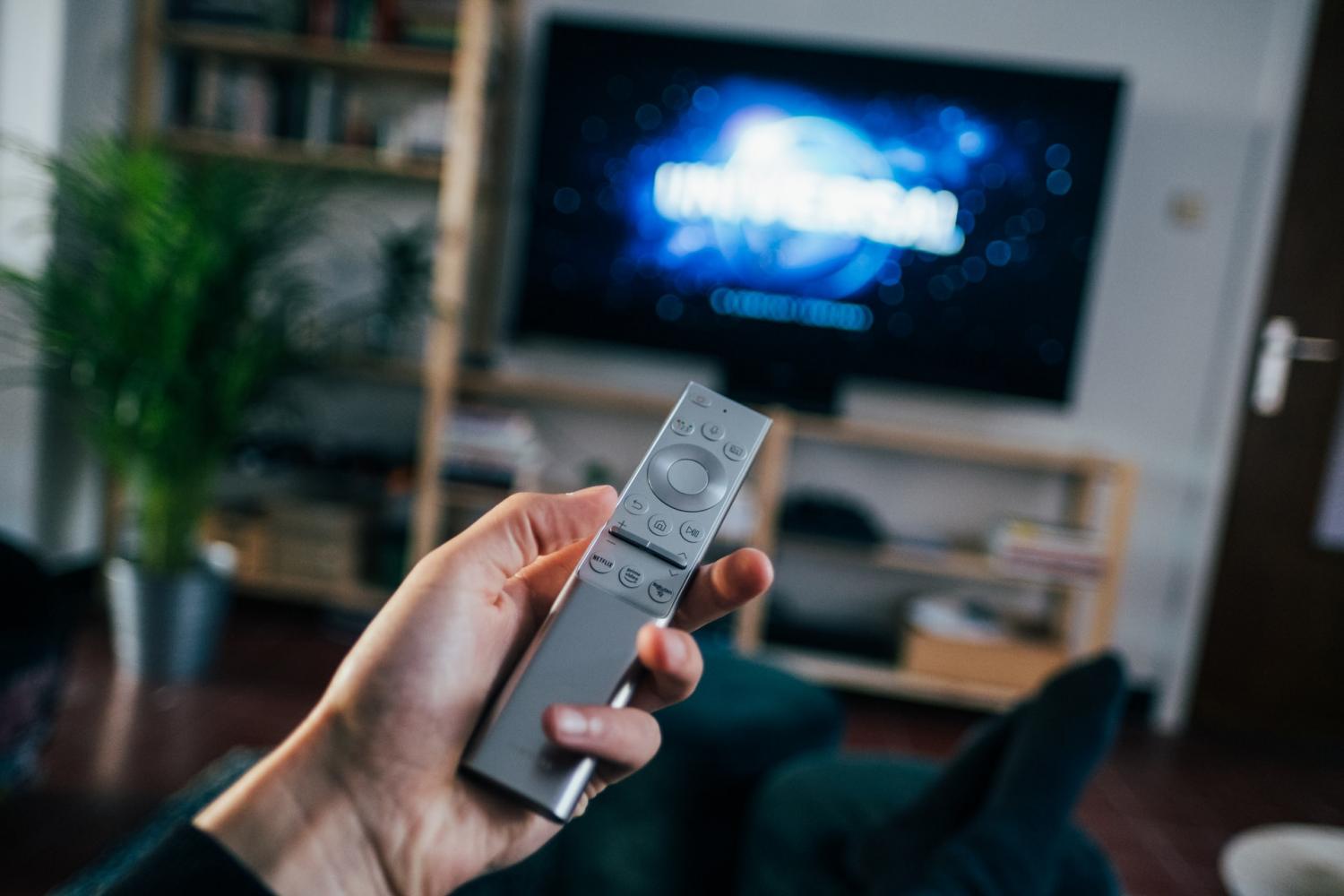
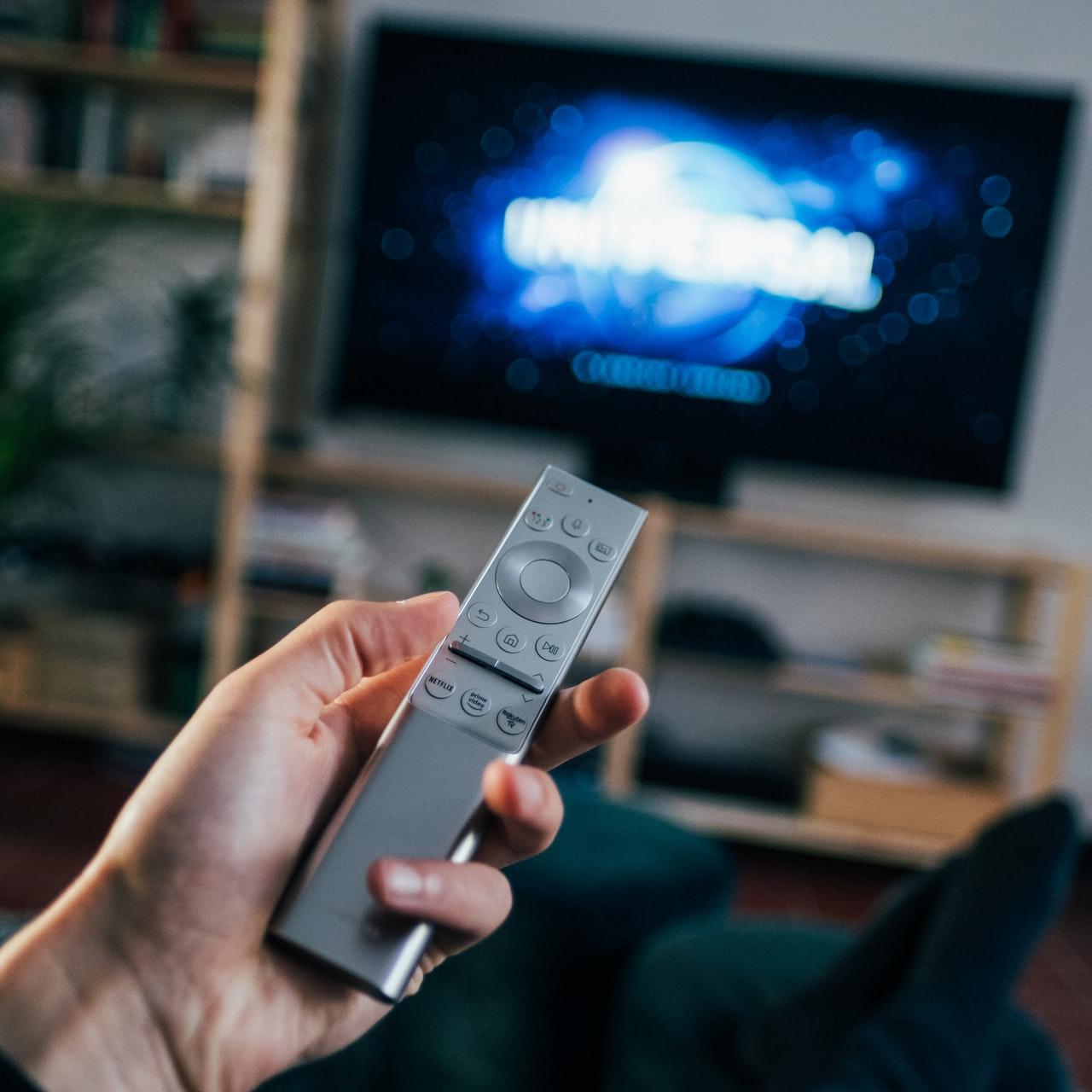
You’ve already binge-watched Tiger King and Normal People during lockdown, so what’s the next course in your televisual feast? Acre has devised a list of Top 11 sustainability documentaries to give you food for thought. Stay safe and enjoy.
1. Where the Future of Fashion is Headed
The fashion industry is the most polluting after oil and more than 100 billion new garments are produced each year, a third of which are never sold or worn.
Enter the sustainable fashion pioneers. They show how to lower the carbon footprint of your clothing and embrace the circular economy.
The documentary features Vin and Omi, who use their plantation in the Cotswolds to transform plants such as nettles and cow parsley into fabric fit for the catwalk. They also make “leather” from the skins of tree mushrooms and horse chestnuts.
Tasteful. Literally.
https://documentaries.io/where-the-future-of-fashion-is-headed-vpro-documentary/
2. Minimalism: A Documentary About the Important Things
This Netflix documentary confirms that we don’t need the biggest house, latest iPhone or a gleaming Porsche to make us happy. Featuring the Minimalists, Joshua Fields Millburn and Ryan Nicodemus, it looks at people who have downsized, decluttered and brought positivity into their lives along the way.
Joshua and Ryan had high-powered jobs and all the gadgets, but realized they always wanted more. The documentary demonstrates how you can live a more meaningful life with less. Warning: you’ll feel compelled to rid yourself of all of your extra clutter… but in an environmentally-friendly, sustainable way of course!
https://www.netflix.com/gb/title/80114460
3. Chasing Coral
We all know that coral is vanishing – in the last 30 years, we have lost 50 per cent of the world’s reefs. This documentary takes you on a virtual dive to see the devastating effects of global warming.
A team of scientists, divers and photographers spent more than three years shooting more than 500 hours of underwater footage to create the result.
We get to share in their highs and lows as they shine a light on the damage being done to ecosystems that are not only crucial to the health of the oceans but support the livelihoods of up to a billion people.
https://www.chasingcoral.com/
4. Our Planet
Netflix signed up Sir David Attenborough to add his dulcet tones to this big-budget nature series, which is to his usual high – and often breathtaking – standards.
The eight episodes took producer Alastair Fothergillfive years to create – he was also behind the BBC’s Planet Earth, Blue Planet and Frozen Planet–and it doesn’t disappoint. The series has a strong sustainability message, and with a bit of luck will leave a lasting impression on Netflix’s global audience.
https://www.netflix.com/gb/Title/80049832
5. The Biggest Little Farm
Molly Chester and her Emmy Award-winning director husband, John, leave their apartment in Santa Monica to fulfil their dream of living on a farm in Moorpark, California.
These guys are hell-bent on living the Good Life and this heart-warming docu-film follows their journey as they learn to farm the eco-friendly way.
Of course, it’s not all pretty flowers and pink piglets. There’s plenty of drama (growing threat from wildfires) and gloom (coyotes becoming “well acquainted” with their poultry), and, of course, masses of muck.
https://www.biggestlittlefarmmovie.com/
6. A Plastic Ocean
Journalist Craig Leeson and free diver Tanya Streeter illustrate the consequences of eight million tonnes of plastic being dumped into the oceans each year.
The result is shocking. Plastic is not only posing a threat to marine life but is also in our food chain. There’s poignant footage of seals and turtles strangled by plastic and dead birds that never stood a chance.
The documentary stresses that it isn’t too late for us to make the change for a better future and that simple measures such as recycling and using reusable containers can make all the difference.
7. The Game Changers
This documentary shows how eating greens (and avoiding meat) can help you to go green, as well as being good for your health.
It also provides an argument for high-performing athletes to eat a primarily plant-based diet. Former professional mixed martial artist James Wilks, who suffered a broken vertebra in competition, discovers that to make the best recovery, the lentil may be mightier than the lamb chop.
Want to be vegan and as strong as an ox? Well, when did you last see an ox eat meat?
8. Earthlings
Animal lovers will find this documentary a very difficult watch. It looks at how animals are subjected to horrendous abuse for our food, scientific experiments, fashion and entertainment. And it pulls no punches in showing distressing images from laboratories and fur farms.
It takes nothing away from a human to be kind to an animal, says narrator Joaquin Phoenix. After watching this you may never want to eat or use animal products again.
9. An Inconvenient Sequel: Truth to Power
Ten years after his Oscar-winning documentary, An Inconvenient Truth, was aired, Al Gore returns to ramp up efforts in the battle against climate change.
He notes that the most criticized scene in the first documentary surrounded the ability for climate change to create real destruction in places such as the World Trade Center memorial site. These claims were pooh-poohed as an exaggeration. Enter Hurricane Sandy, which flooded the 911 memorial site, as predicted.
“It is right to save humanity, it is wrong to pollute this earth”, notes Gore.
https://www.amazon.co.uk/Inconvenient-Sequel-Truth-Power/dp/B074WGH2C4
10. Waste Land
Jardim Gramacho outside Rio de Janeiro was the world’s largest landfill site before its closure in 2012 when toxic waste started leaking into the sea. Those who lived nearby earned a crust by sifting through the mountains of rubbish.
This heart-warming documentary tells the story of Vik Muniz, a renowned New York artist, who came to make portraits of the scavengers. His aim? To sell the paintings and give the money directly back to the people in them.
Waste Land gives an insight into the lives of the adults and children who spend their days on the dump and showcases the power of art and its ability to bring out the beauty in people.
https://www.amazon.co.uk/Wasteland-Vik-Muniz/dp/B00ET1Q9YW
11. Down to Earth
Zac Efron co-presents this new Netflix docuseries, alongside his friend and wellbeing specialist Darin Olie.
Viewers travel vicariously as the duo embark on global trips from Paris to Costa Rica to investigate sustainable lifestyle choices and technologies.
The first episode sees the lively pair in Iceland, baking rye bread in a volcanic hot spring, dining on dung-smoked bacon and visiting a renewable energy power plant, where eco innovators demonstrate their efforts in the fight against climate change.
“Change has to start somewhere. Maybe it’s time we all change,” says Zac. He also says “rad” and “stoked” which are words probably better left at the skatepark, but then again sustainability should get people this excited.
https://www.netflix.com/gb/title/80230601
If you’ve watched any sustainability documentaries that you’d like to share with the Acre team, let us know which ones you recommend. Contact us at uk@acre.com.
Previously published in the 3BL Media newsroom.
Image credit: Jonas Leupe/Unsplash
Regenerative – The Word Defining Global Food and Ag in 2021


Regenerative could become the key word that sums up 2021 if the new COVID-19 vaccines are effective and their distribution can be scaled worldwide. But in any event, recent trends in the global food sector suggest regenerative agriculture will become more mainstream in 2021 as both consumers and companies realize we’ve got to find a way to tackle global emissions in the coming decade.
Regenerative agriculture is a farming approach that has some similarities to organic agriculture, with the primary goals to build up soil health, sequester carbon, conserve water and improve air quality. Such farming methods also seek to decrease the consumption of fertilizer, fuel, and other resources used widely in modern agriculture. Not everyone agrees with the claims regenerative agriculture’s supporters have made about it could emerge as a leading way to take on climate change. Nevertheless, tactics that encompass this method of farming, including no-till planting and the inclusion of cover crops on farmland, can help make the food and agriculture sector become more responsible and sustainable.
The bottom line is that as companies seek to burnish their sustainability credentials while convincing consumers their products are the responsible ones to purchase, regenerative agriculture will be here to stay – and don’t be surprised if you see more labels touting the benefits of food products sourced from farms that deploy this method of farming.
To be fair, in 2019 Whole Foods said “regenerative” would be the top food trend for this year, but of course the pandemic disrupted everything, and images of empty store shelves from this spring instead, sadly, summed up the food industry during 2020. But assuming we emerge from this pandemic in the coming months, regenerative agriculture will score renewed interest in the coming year – and the following food and beverage companies have already set the foundation for how companies and their suppliers are rethinking agriculture.
General Mills: 1 million acres of regenerative farmland by 2030
Touting the widely accepted “six principles” of regenerative agriculture, General Mills has been one of the biggest proponents of such farming methods. The company has promised to scale up such farms across the U.S. and Canada over the next ten years. Products that are a result of General Mills’ dabbling in ingredients that are a result of regenerative agriculture include mac and cheese, graham crackers and breakfast cereal.
Start while they’re young
Danone’s Happy Family Organics is buckling up for the regenerative agriculture trend. Last year, the purveyor of baby food and snacks said it sourced 300,000 pounds of produce from farms that have harnessed regenerative practices – if all goes to plan, that amount will surge almost seven-fold by the end of this year.
The regenerative agriculture moonshot
Watch how Moonshot Snacks performs over the next few years to see whether this trend truly takes hold. At a time when companies are still churning out as many organic products as possible, Moonshot is calling itself the “climate friendly cracker” maker instead. Currently selling three flavors of snack crackers, the company only sources sunflower oil and wheat from regenerative farms. Moonshot’s website is not only effective at promoting its crackers, but serves as a great primer for consumers who need to wrap their heads around the concept of regenerative agriculture, too.
We’ll drink to that…
Moving onto products more appropriate for those of a certain legal drinking age, California’s Bonterra Organic Vineyards has concluded regenerative agriculture stores more carbon in the soil than conventional farming methods. The winery has worked with its peers to explore ways to reduce their water footprint while eschewing the use of chemicals for more natural forms of pest control.
…And have a cold one while you’re at it
Moving onto brewskis, Anheuser-Busch announced earlier this year it would explore regenerative agriculture for its supply chain with the sustainable agriculture firm Indigo Agriculture. The partnership is focusing on rice, as the beer giant has used that grain to brew its famous Budweiser brand of beer since the 19th century.
Leading the regenerative culture shift
The labels may say “organic,” yet Stonyfield is among the pioneers of the regenerative farming movement. The popular yogurt brand says it’s long strived to be a partner with organic dairy farms to improve their management practices, and has also been developing tools that can help them secure soil health. It’s channeled that energy into political activism, encouraging consumers to join them on the “We Are Still In” climate action pledge.
Image credit: Roman Synkevych/Unsplash
Companies Can Address the Impact of Single-Use Plastics in the Era of COVID-19
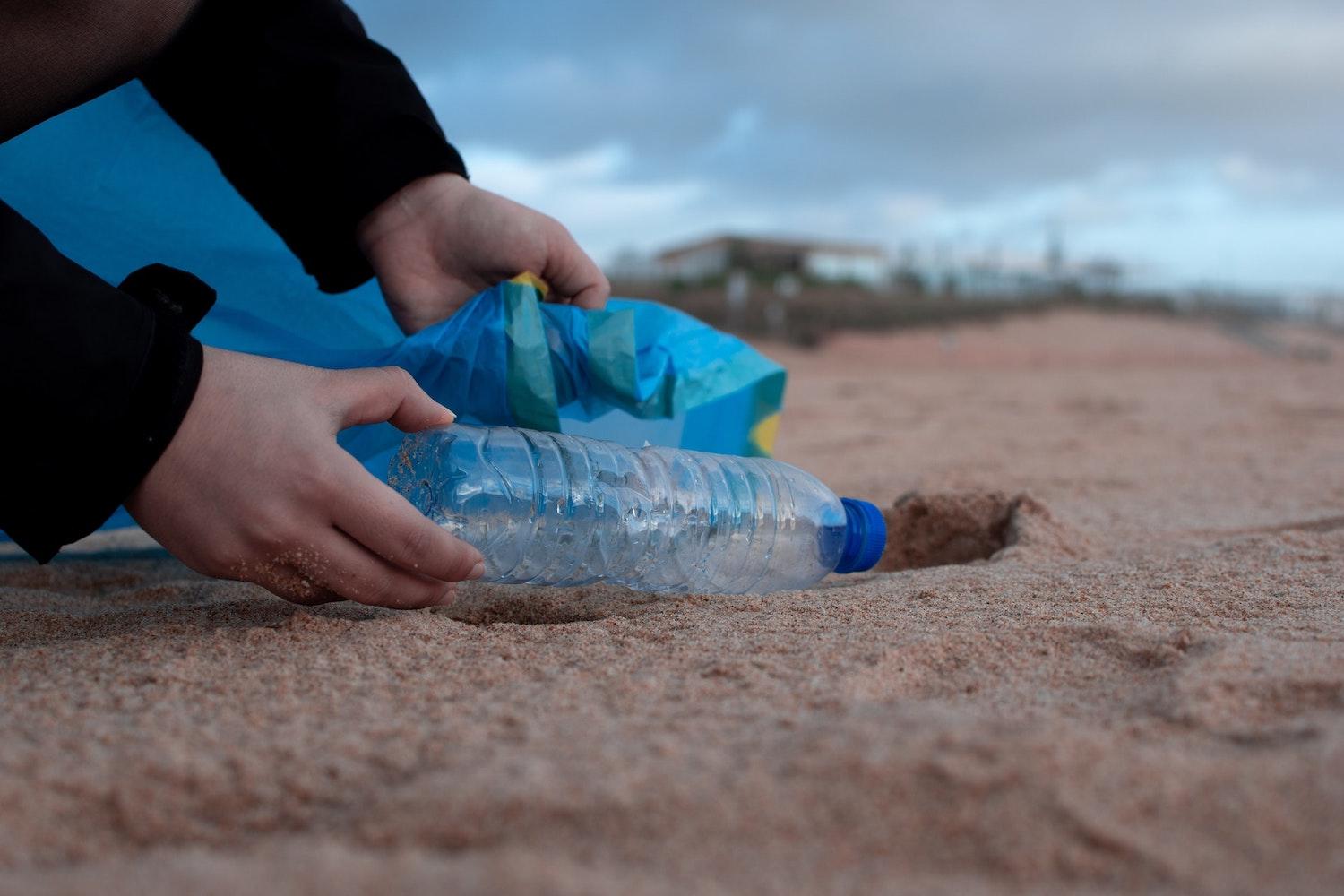
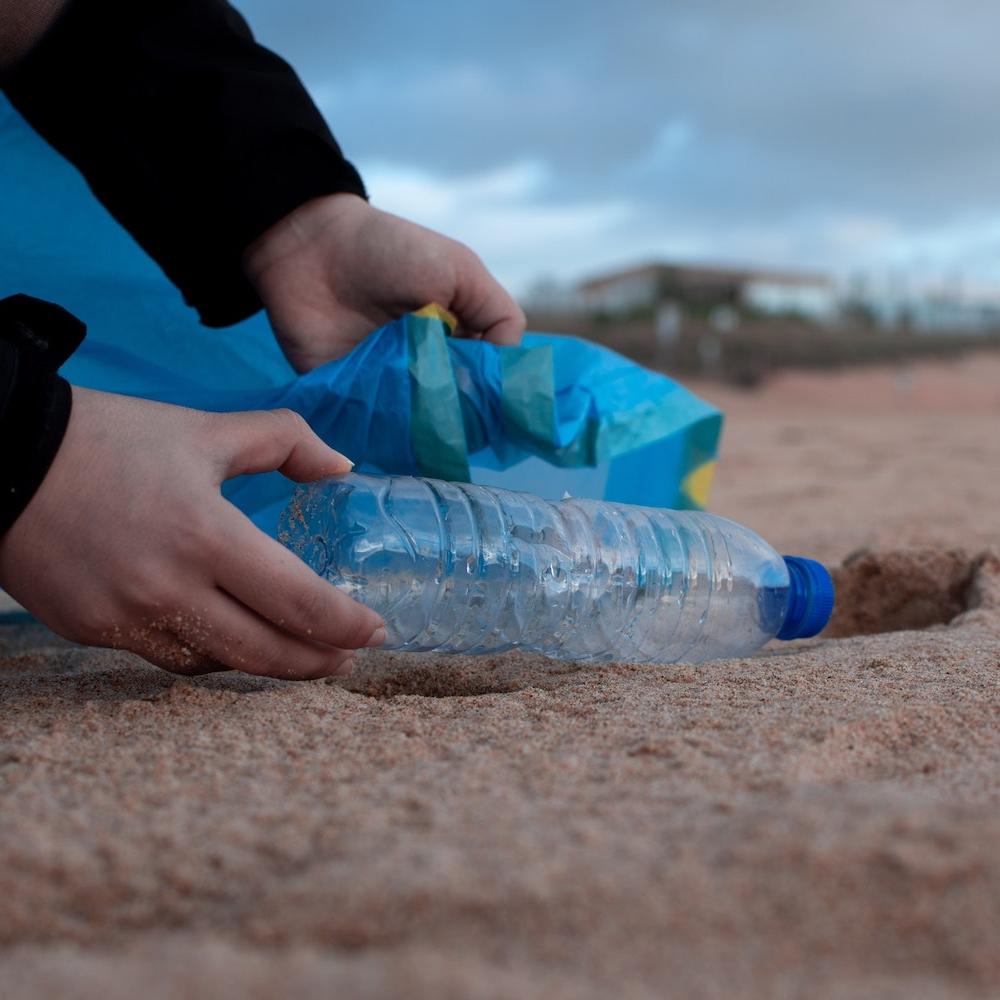
As people attempt to go about their daily routines safely during the novel coronavirus pandemic, the role of plastics has changed once again. Cities and states temporarily lifted their plastic bag bans out of concern for health and hygiene, cafes restricted the use of reusable cups, and take-out orders surged while people sheltered in place. With a surge in the use of personal protective equipment, evidence suggests items such as masks and gloves are ending up as pollution in the environment.
Regardless of the trends toward rising consumption of single-use plastics, companies are moving forward with long-term commitments to meet customer needs while propelling innovation that reduces plastic waste. The need is urgent on both fronts.
Up to our knees in plastic waste
Marine pollution has become of particularly serious concern because so much waste ends up in oceans through runoff and industrial activities. When it becomes pollution, plastic waste can remain in the environment for centuries. This trend has a cost. In 2018, 87 coastal countries saw between $6 billion and $19 billion in economic loss from marine plastic pollution, affecting industries such as marine tourism, fishing and aquaculture, according to a 2019 study from Deloitte.
Before the coronavirus was declared a global pandemic in March, governments and businesses were increasingly phasing out single-use plastics as awareness of this problem grew. California became the first U.S. state to enact a plastic bag ban six years ago; in the years since, companies have been announcing plastic reduction commitments with the aim of shifting toward a circular economy.
“The plastic reduction movement was in full swing and moving faster than any environmental issue I’ve ever worked on,” Martin Bourque, executive director of the Ecology Center in Berkeley, California, told The Guardian in July. “Since March, it’s all been on hold.”
Today, the world has to grapple with increased waste and decreased recycling. The Thailand Environment Institute, for example, reported that the country’s plastic waste has increased from 1,500 tons a day in normal times to 6,300 tons daily amid COVID-19. In the United States, curbside recycling pickup was suspended in areas such as Los Angeles and Miami-Dade.
All of this plastic waste has led NGOs and companies to come together to address the problem. In October, the World Wildlife Fund (WWF) and the Ellen MacArthur Foundation recommended a binding international treaty to address plastic pollution. This call to action was backed by a manifesto signed by dozens of companies including Nestlé, PepsiCo, Tesco, Coca-Cola Co. and Kimberly-Clark.
“In a business-as-usual future, by 2040 there will be two times the current plastic generation, three times the current plastic leakage into the ocean, and four times the current plastic stock in the ocean,” Erin Simon, head of plastic and business for the World Wildlife Fund (WWF), told TriplePundit in an email. “This would be catastrophic for ecosystems and wildlife around the world, not to mention impacts to human health and local economies.”
It is even possible to make progress while the world is on pause?
While the pandemic has forced unsustainable behavior on so many individuals and businesses, some companies have found it natural to make commitments and continue innovating toward sustainability.
Kimberly-Clark Corp., known for brands including Cottonelle, Kleenex, Huggies and Kotex, has been considering its plastic footprint and over the past year has launched a bold, ambitious strategy to reduce it. Like most household brands, its array of products tends to rely on plastic in substance and packaging, but the company placed its plastics footprint on top of its 2030 sustainability agenda in July.
For Ori Ben Shai, vice president and managing director of Kimberly-Clark U.K. and Ireland, the impetus to shift away from single-use plastics is highly personal. When he first took the helm in the U.K. in 2019, after two years of overseeing Kimberly-Clark’s business in Israel, Ben Shai found a stack of letters from consumers and sat down to learn more about what people in this new market had to say. Inside, he found a note from a 10-year-old girl voicing her concern about the amount of plastic in Kimberly-Clark’s products. Her words were poignant and touching, and in part they helped to influence the release of improved, resource-efficient versions of some products.
"We see ourselves as leaders, and we love consumers that are leaders in doing what they believe is right. If we address their needs first, we will be addressing the world’s challenges too,” Ben Shai told TriplePundit. One example of a quiet shift that’s happened since is removing plastic handles from Andrex toilet tissue packages and using 30 percent recycled plastic for the brand’s packaging.
In another move forward, earlier this year the company joined the U.S. Plastics Pact, a collaboration between major brands and NGOs such as WWF. This coalition helped Kimberly-Clark identify additional goals that can complement its 2030 vision while accelerating its sustainability agenda even further. For instance, while the company’s 2030 vision reaches for 20 percent recycled content across the company’s plastic packaging by 2025, the Plastic Pact aims for 30 percent recycled or responsibly-sourced bio-based packaging by the same year. Kimberly-Clark is also a member of the similarly aimed U.K. Plastics Pact, which launched in 2018 and now includes more than 100 global consumer brands.
Ben Shai said it would have been easy for Kimberly-Clark to say plastics just aren’t the priority in this moment, but the company’s reaction was just the opposite. “If anything, this pandemic shows us how fragile our world is, and it reminds us that we have a huge responsibility to protect the world we all live in,” he told 3p.
Some keys to circularity in a single-use pandemic
How can companies keep up with their plastics commitments in these trying times? Ben Shai noted some keys that helped Kimberly-Clark stay on top of its goals.
Keeping a long-term view has enabled the company to continue improving its offerings, even if they’re not yet perfect, and Kimberly-Clark has also been careful to keep in touch with its customers, Ben Shai said. “Driving positive environmental impact has to be a partnership between us as an industry leader and consumers,” he explained.
In crafting the Huggies Tiniest Footprint Promise, for example, Kimberly-Clark was careful to include customers and consumers in the sustainability journey. Last year, the company announced that its Huggies baby wipes contain 50 percent less plastic than competitors, and that the wipes would be plastic-free with recyclable packaging within the next five years. The brand also recently launched biodegradable Huggies wipes in the U.K. Of course, circularity is a two-way street, and the brand also asks that consumers do their part by keeping wipes out of the toilet and recycling the packaging when possible.
Collaboration with nonprofits, advocacy groups and other brands is also critical, Ben Shai said. One benefit of both the U.S. and UK Plastics Pact is the collaborative foundation: Businesses, governments, NGOs and researchers are lifting each other toward a common goal. “This is an example where we need to all work together for the benefit of our planet, and when we do that, that's where we have the best chance of doing it properly,” Ben Shai told us.
By joining these initiatives, “Kimberly-Clark has taken the most important first step by committing to measure and annually report their impacts on the plastic waste system,” said Simon of the WWF. “Anyone willing to pull back the curtain and take a data-driven approach to improvement is an ideal partner for us in helping to take on this complicated problem and ultimately achieve No Plastic in Nature by 2030.”
It’s a sad day when people have to choose between what’s best for their family and what’s best for the planet, Ben Shai contends. Although plastic pollution may seem just out of view during the coronavirus pandemic, the problem is literally right under our noses — and the time is now for companies to respond.
This article series is sponsored by Kimberly-Clark and produced by the TriplePundit editorial team.
Image credits: Marta Ortigosa and Daria Shevtsova via Pexels
In the Face of the Climate Crisis, Countries Are Increasing Fossil Fuel Production, Report Warns


The Production Gap, a recent report from the United Nations and several partners, delivered some unsettling news: Countries around the world are ramping up production of fossil fuels, despite an urgent need to meet climate goals and the increasingly uneconomic future of the fossil fuel sector. According the the report, global production of coal, oil and gas must decrease by 6 percent each year until 2030 for countries to cap global temperature rise at 1.5 degrees Celsius as agreed upon in the Paris climate accord. But nations are instead planning production increases of 2 percent a year. Further, G20 countries have committed $233 billion in COVID-related funding to the fossil fuel sector, compared to $146 billion for clean energy.
The longer we wait, the harder it will be
Before the coronavirus pandemic, fossil fuels had started to become more and more uneconomic compared to renewable energy. Since the pandemic began, renewables have tipped into being a cheaper electricity source than fossil energy. But as the U.N. report shows, the bulk of energy-related money in U.S. COVID-19 recovery stimulus has gone toward the fossil fuel industry with no strings attached. The second biggest chunk of funding went to clean energy, but with conditions. Right out of the gate, the market signals are skewed: At this point, propping up fossil fuels looks like putting a dying industry on life support rather than easing the economy’s transition to a cleaner, more resilient future.
The longer the inevitable end of fossil fuels is prolonged, the more disruptive the end will be. A gradual, managed decline will not only allow investors to realign their portfolios and goals, but also give governments and businesses time to prepare for a shift in economic processes and for a more just and equitable transition for affected communities.
The time is now to invest in communities largely dependent on fossil fuels
Overall, the U.S. receives a relatively small share of its GDP from fossil fuel production because of its diversified economy. However, production is concentrated in select regions of certain states — oil in parts of Texas, coal in parts of Kentucky, natural gas in parts of Pennsylvania. The end of fossil fuel production will be disruptive to those communities. But managing the transition will enable those communities to adjust and adapt with support from governments and investors.
Many of the affected communities will require financial, technical and capacity-building support. Job training and education, as well as social safety nets during the transition, will be required. It cannot be left to local governments or nonprofits alone to provide support. The federal government is equipped to help. If it does, it will send a powerful signal to investors to put private money into promising communities. During the American Recovery and Reinvestment Act of 2009, for example, the U.S. Department of Energy provided technical support to help states develop energy-efficiency programs and set up funds to transition workers into well-paying energy-efficiency jobs. These energy-efficiency jobs then boosted local economies and enabled $150 billion of private investment in communities across the country.
In addition to high-quality jobs, clean energy has other knock-on effects that benefit communities, especially low-income communities and communities of color — those who not only bear the burden of climate change, but are also being hit hardest by the COVID-19 pandemic. Fossil fuel production has detrimental effects on air and water quality, creating public health problems long before COVID hit.
A new day
A transition from fossil fuels to renewable energy will not be easy for communities that currently rely on fossil fuel production for their economic wellbeing. But a managed, planned transition will make it much smoother. Such an effort must be inclusive, engaging with the communities that it will affect. Change is a daunting prospect — especially in communities that have relied on one source of economic prosperity for generations, as is the case in many oil and coal towns across the U.S. It will require a different way of doing things, but it can also mean a turning point.
For example, many west Texas oil communities suffered in the years after the oil bust in the 1980s, with some towns close to shutting down. But in 1999, Texas passed a renewable energy standard for wind energy, and the money poured in as developers aimed to take advantage of an opening in the market. Communities once on the brink are now vibrant, buoyed by wind farms that stretch as far as the eye can see — and Texas is now a global leader in wind energy. Many people didn’t like the wind turbines when they first arrived, but after 20 years, they are as much a part of the landscape as the cattle that graze beneath them.
Stalling the inevitable transition to a clean energy economy is a short-term strategy. Better to make a plan with clear regulatory direction, financial and technical support, and opportunities for the private and public sectors to work with communities to make a better economic and environmental future. It’s a clear direction for long-term gain.
Image credit: Zukiman Mohamad/Pexels
Shark Tank Star Gets COVID-19 Response Right, So Where Are the ‘Real’ Business Leaders?
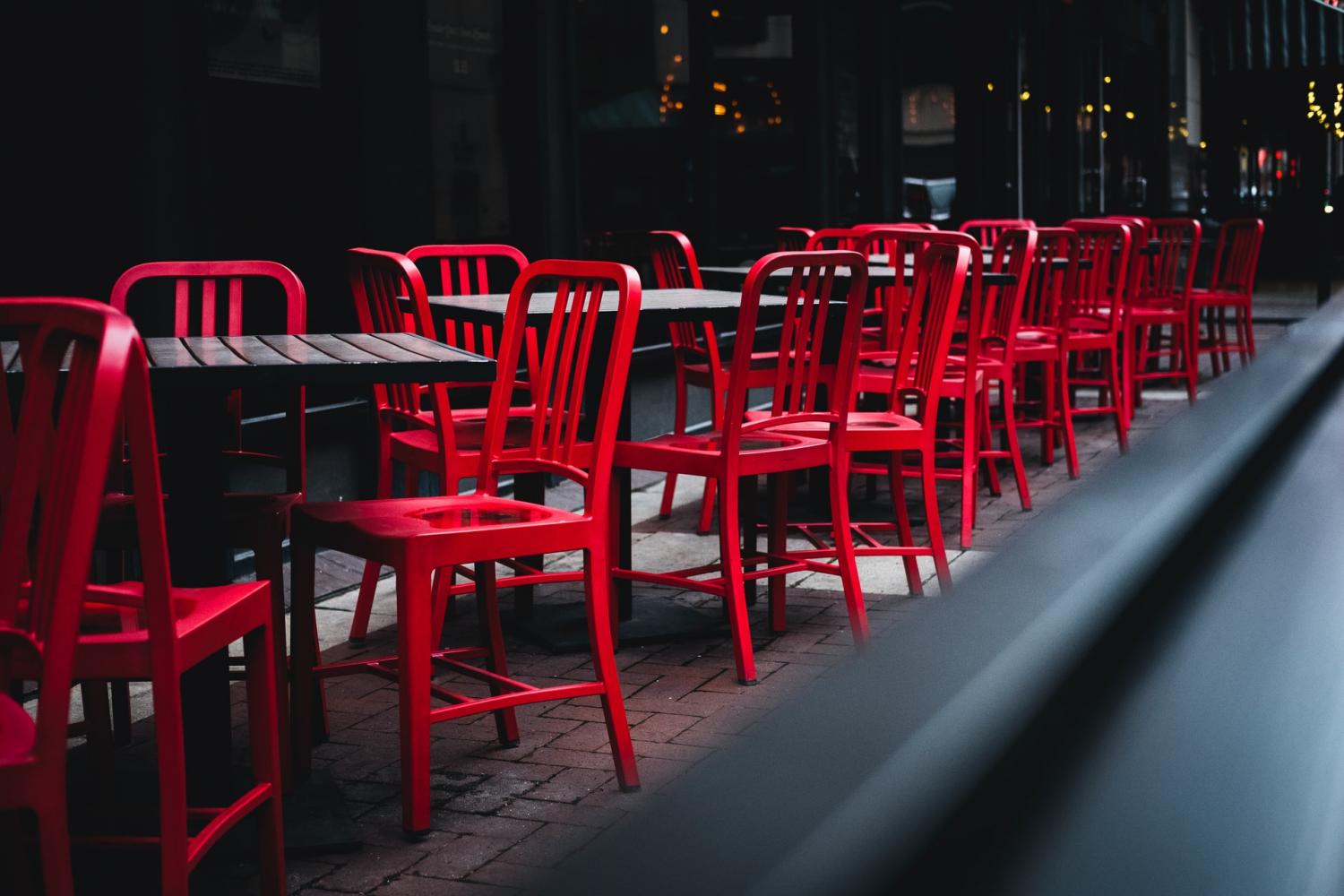
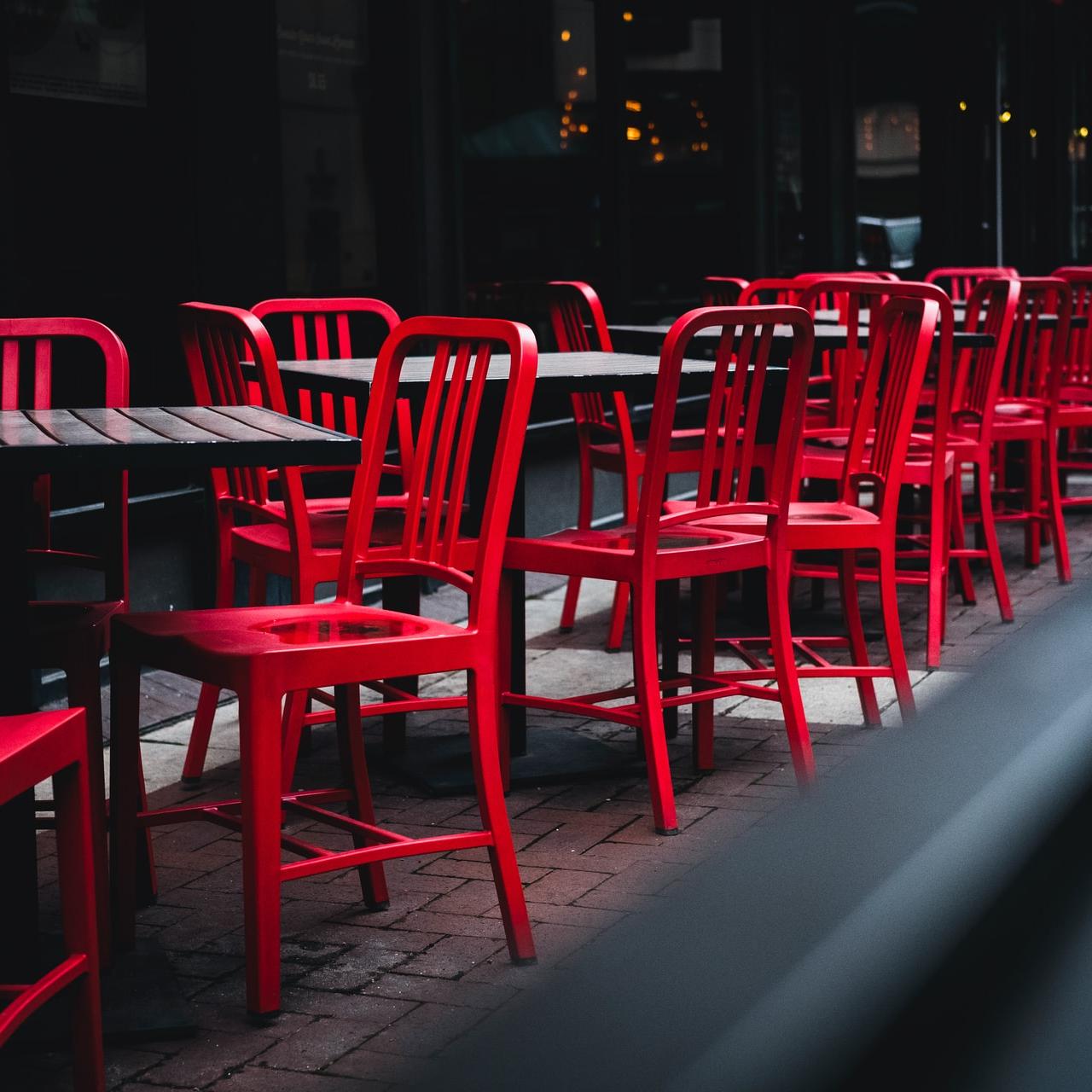
In a classic case of fiddling while Rome burns, President Trump continues to ignore pleas for a national plan on a COVID-19 response even as the crisis reaches new heights of destruction. High profile CEOs have so far failed to rally their peers to press for action, but Shark Tank investor Kevin O’Leary finally set the tone earlier this week, when he deployed his media platform to make the case for coordinated federal action on COVID-19.
Misdirection on public health guidelines to fight COVID-19
O’Leary does have the advantage of a baked-in bullhorn, through his role in the popular ABC television series Shark Tank, in which contestants compete for seed money to start small businesses (CNBC, which is owned by Comcast through NBCUniversal, syndicates the series).
He also speaks from the perspective of experience as an investor in Shark Tank businesses, many of which have been affected by the COVID-19 outbreak.
O’Leary and CNBC deployed that platform to advantage on Monday. He appeared in the CNBC morning news program Squawk Box, and the CNBC website later wrote up the interview in an online news article.
In the article, O’Leary focused on the patchwork of state and local COVID-19 regulations that has wreaked havoc on small businesses, including restaurants in which he owns a stake.
In particular, O’Leary cited a new round of lockdowns in California. Restaurants have already poured scarce resources into building outdoor dining areas to comply with state- and local-level COVID-19 guidelines, only to see them shut down again.
“My question is very simple: Who decides? Is it at the city level, the state level, the federal level? Tell me what the rules are, so I can make economic decisions on behalf of my employees,” O’Leary said.
“There are no rules,” he continued. “They’re not the same. It’s total chaos out there. It’s obvious that’s the situation, and it’s totally unfair.”
Though O’Leary’s focus was on the plight of small business owners, that “no rules” comment applies equally to rules that should be intended to protect workers from abuse.
Chief among those rules is wearing a mask and maintaining social distancing. That sounds simple enough, but instead, the president, his allies, and members of his administration have crisscrossed the country to hold events without masks or adhering to social distancing guidelines. The result is that ordinary public-facing workers are experiencing abuse and violence simply for following basic public health guidelines.
Misdirection on help for small businesses
In the same interview, O’Leary also advocated for federal COVID-19 relief funding to go directly to workers rather than to employers.
The argument in favor of direct relief to individuals also echoes O’Leary’s own experience. At the beginning of the outbreak he encouraged the businesses under his investment umbrella to apply for federal Paycheck Protection Program loans, but he soon realized that many of them would go under despite the assistance.
O’Leary’s cynical take on the Paycheck Protection Program was borne out last week, when the Small Business Administration finally released data on PPP loan beneficiaries. The data revealed an apparent pattern of self-dealing on the part of the Trump family in addition to other issues that may have shifted funds away from small businesses and failed to achieve the program’s intended purpose of preserving jobs.
NBC was one of 11 news organizations that sued for release of the data. The network reported troubling patterns of abuse in a federal program that was supposed to help small businesses keep workers on their payroll during the worst of the crisis (as with CNBC, NBC is a Comcast entity).
Among the findings reported by NBC, 25 loans totaling more than $3.65 million went to businesses that paid rent to properties owned by Trump and his son-in-law (and high-level advisor to the president) Jared Kushner.
“Fifteen of the businesses self-reported that they only kept one job, zero jobs or did not report a number at all,” NBC noted.
In one of the most apparently egregious examples, a loan of $2,164,543 loan went to the Triomphe Restaurant Corp., located at the Trump International Hotel & Tower in New York City.
“The company reported the money didn’t go to keeping any jobs. It later closed,” NBC reported.
Misdirection on the future
Other news organizations found similar issues. The Washington Post, for example, reported that more than half of the loans went to bigger businesses. Albuquerque Business First highlighted several PPP loan success stories in New Mexico, but the news organization also noted substantial issues and information gaps in the data set. For example, the available data indicated that more than 15 percent of approved loans showed no indication that the loan would save any jobs.
Republicans members of Congress have dithered over a second round of relief for months, sheltered by the refusal of Senate Majority Leader Mitch McConnell (R-KY) to bring bills to the floor.
Even if a bill is approved, the damage to existing businesses has already been done. In September, Fortune was among the news organizations reporting that approximately 100,000 “temporary” business closures had become permanent.
On the bright side, many new small businesses have been created during the COVID-19 crisis, but they face a daunting task. The outbreak has only worsened since then, setting new records for infections, hospitalizations and deaths on a regular basis.
With the U.S. healthcare system overwhelmed and mass vaccination not expected until next summer at the earliest, other states aside from California are considering another lockdown in order to preserve beds in intensive care units.
As of press time, the president has still not provided any guidance that could save lives and livelihoods in the coming months, though the First Lady did publicly announce the completion of the new Tennis Pavilion at the White House earlier this week.
Where are the leaders?
The coming months look grim indeed, and the latest reporting on vaccine availability does not bode well for the future.
Earlier this week, The New York Times reported (and the Associated Press confirmed) that the Trump administration failed to exercise a contractual option that would enable the U.S. to purchase 500 million additional vaccine doses from Pfizer, leaving the country with only 100 million doses. With a two-dose regimen, that covers 50 million people in a nation of almost 330 million.
The White House pushed back on that report and denied that the nation would fall short on vaccine supply. However, a red flag was raised on Monday when both Pfizer and another top vaccine contender, Moderna, declined an invitation to appear at a “Vaccine Summit” at the White House scheduled for Tuesday.
Both companies are expected to gain FDA approval for their vaccines this week, but questions about vaccine availability are all but certain to linger for weeks if not months.
Meanwhile, with the notable exception of Kevin O’Leary, business leaders have failed to mobilize their influence to call the president to account for self-dealing, corruption and incompetence, if not sheer maliciousness, on his handling of the COVID-19 crisis.
Perhaps cracks in the facade are finally beginning to appear. Earlier this week, the Nevada healthcare organization Renown Health drew media attention when it set up a temporary COVID-19 field hospital with a 1,400 bed capacity in a converted garage at its Reno hospital, only to have the president himself tell his millions of Twitter followers that the facility is a “'fake hospital’ and is not treating any patients.”
Anthony Slonim, an MD who is the CEO of Renown, spoke to Becker’s Hospital Review and drew attention to the president’s failure to lead.
“As a public health professional, I know the responsibility I have for prevention, and screening, and preparation is not to wait until I need it," Slonim said. "It's to anticipate. That's called planning. We're supposed to do that as leaders.”
Over and above the possibility of a vaccine availability debacle next year, Trump failed to anticipate and plan for COVID-19 every step of the way. Before the outbreak, he ignored detailed planning documents left to him by the outgoing Obama administration and withdrew CDC staff from China.
After the outbreak was well under way, he withdrew the U.S. from the World Health Organization and failed to help states coordinate a plan for managing a surge in protective equipment and staffing needs. He shuffled responsibility for public health guidelines onto state governors, many of whom promptly passed the buck to county and local jurisdictions. In any case, he and his circle have persistently ignored those guidelines, such as they are.
It is difficult to imagine a more thorough failure of leadership in crisis, unless it is among the business leaders who have a platform for speaking out in public, and yet have failed to do so.
Image credit: Drew Beamer/Unsplash
Advertising: An Overlooked Contributor to the Climate Crisis
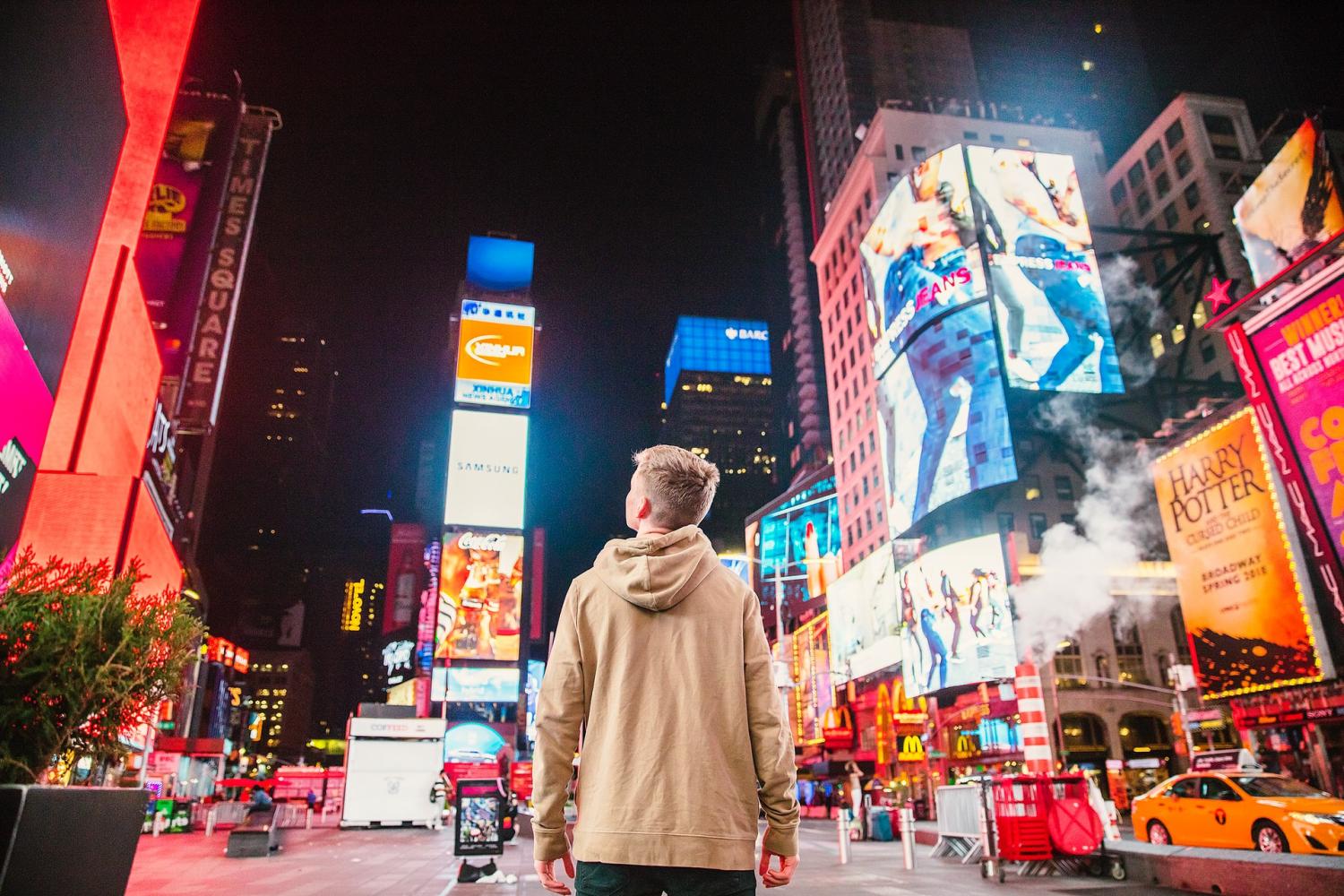
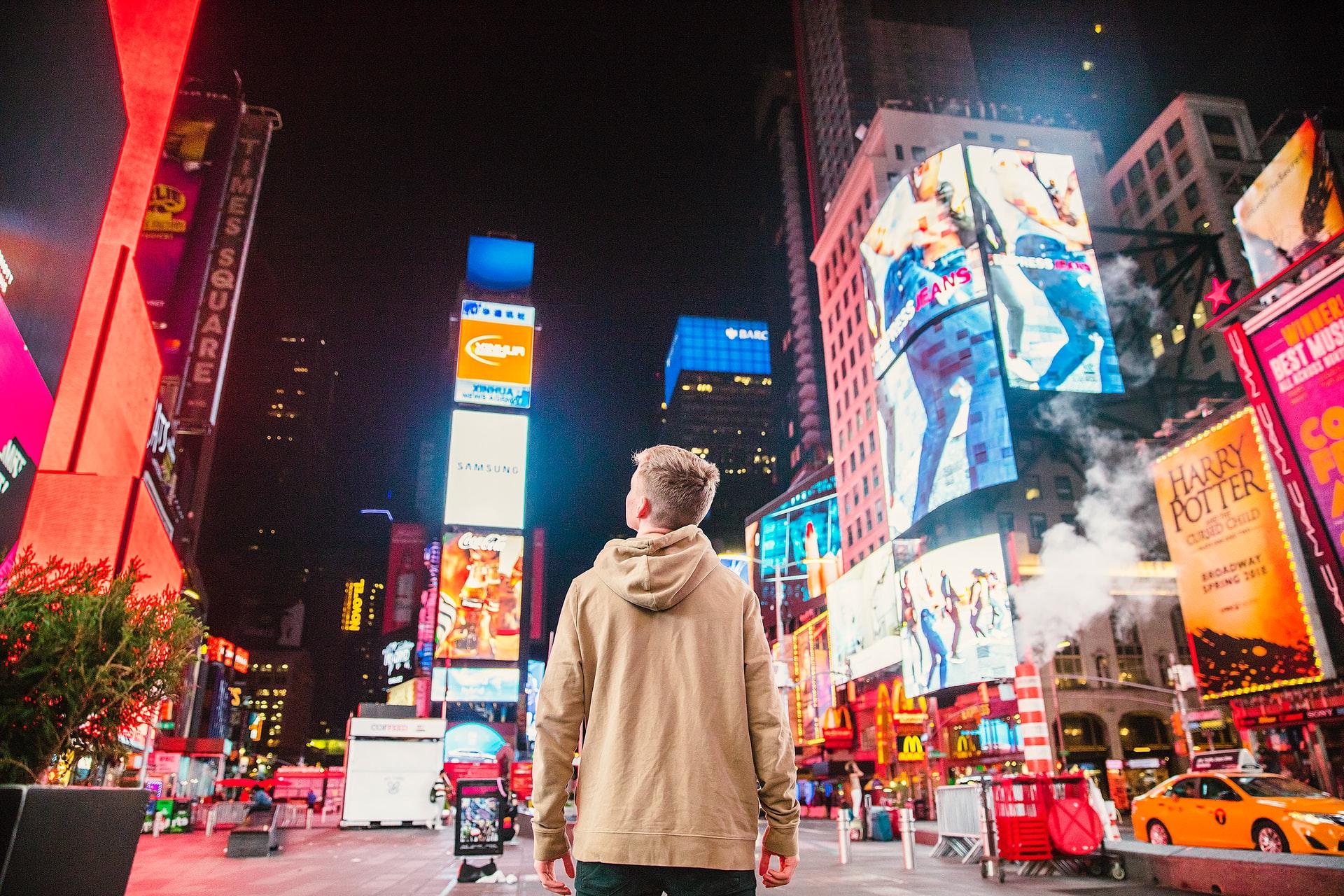
If you made a list of the major contributors to climate change, some usual suspects may spring to mind: airlines and air travel, Amazon Prime and next-day shipping logistics, oil and gas companies, or the methane produced from factory farms, to name some of the most common. However, a new report commissioned by the Badvertising campaign zooms out to take a look at an indirect (but highly influential) background player in the climate crisis: advertising.
When you stop to think about it, advertisements are truly next to omnipresent. Beyond the traditional methods of TV spots, billboards and mailers, ads show up before YouTube videos, in our social media feeds, on our news sites, on the sides of buildings, on cars and in our games.
The ways ads find us are becoming more sophisticated, too. With an ever-expanding toolkit of data collection, algorithms, artificial intelligence (AI) and other advertising technologies, consumers are typically seeing highly targeted, relevant ads for things they're relatively likely to purchase.
All of this is to say: Ads are everywhere — and they exist, generally speaking, to get consumers to consume. “Advertising leads people to place higher value on consumption of what they see advertised and lower value on having more time available for non-work activities," wrote Tim Kasser, an emeritus professor of psychology at Knox College and co-author of the Badvertising report.
A number of studies cited throughout the report support the idea that “exposure to advertising heightens the priority people place on materialistic values and goals” and, problematically, that “materialism is associated with negative ecological attitudes and unsustainable behaviors.”
In one instance, a German study of around 1,000 individuals found that exposure to flight advertisements increased the willingness to fly.
So, whether it’s the suggestion that we hop on a plane to travel to new places, that we lease the new SUV, or purchase another shirt or pair of shoes, the mere exposure to messaging that is designed to get us to consume more seems to be doing its job.
What’s worse is the data suggests that it’s a bit of a vicious cycle, too, in that the more people have materialistic values and goals as a priority, the less they appear to care about the state of the environment. They’re also less likely to do things like recycle or pay attention to or vote for progressive climate policies.
But in this new era where the impact of how and what we consume is under scrutiny, how has the advertising industry managed to fly under the radar in its role pushing activities that heavily contribute to climate change?
One suggestion is that, much like tobacco, advertising is seen as sometimes separate from the product. They’re something of a neutral, there “to carry out the mission,” and the manufacturer or organization is the ultimately responsible party.
The issue is that if they — the ad agency — do their job well, they may be endorsing or encouraging user adoption of products, services, and experiences that play a role in climate change, and in this case — according to this study — there is “a large and growing body of scientific evidence is consistent with the conclusion that advertising indirectly causes climate and ecological degradation through its encouragement of materialistic values and goals.”
So, what do we do?
Regulation is one option. Earlier this year, French lawmakers discussed a bill with the potential to give advertising a main role in moving towards a greener economy instituting a series of progressive bans on the promotion of “toxic” products, giving local politicians more power to regulate advertising, and ultimately changing the conversation to reduce overconsumption.
Stephen Woodford, CEO of the Advertising Association, disagrees. “Banning advertising of certain parts of the economy is not the answer; applying pressure on systemic change in the way an industry operates is, and recognizing that advertising itself will make the best contribution to climate action by helping promoting these critical changes to people and encourage rapid behavior change.”
While the study does not go so far as to make specific recommendations on how the advertising industry should adjust its methods, Kasser concludes, “If humanity hopes to make progress in addressing and reversing climate and ecological degradation, it would be prudent to rein in and change the practices of the advertising industry.”
Image credit: Joshua Earle/Unsplash
LGBTQ Refugees Will Soon Have a Shot at Rebuilding Lives in North America
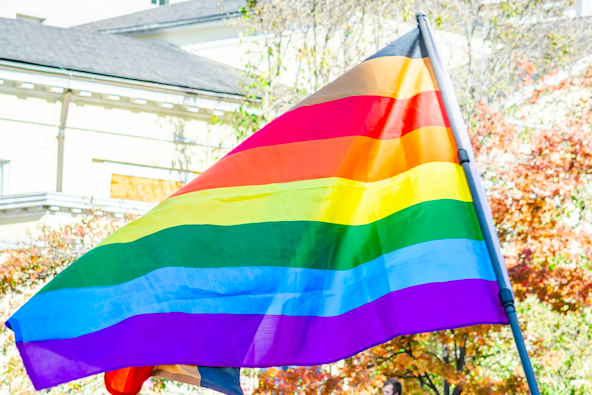
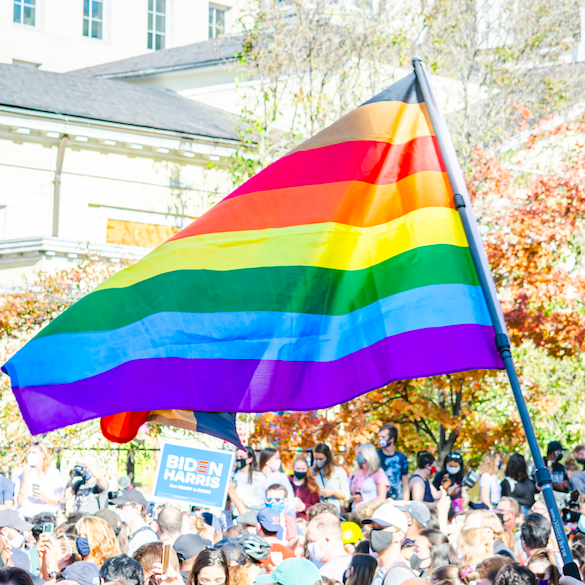
It’s no secret that the outgoing U.S. presidential administration has been hostile to the idea of welcoming refugees. And even though President-elect Joe Biden has plans to reopen the U.S. to people who have been forced to leave their homes, the wait to resettle can still be a long and frustrating one. The waiting and uncertainty can be particularly brutal for LGBTQ refugees, as approximately 70 countries still criminalize same-sex relations, and nine nations impose the death penalty.
Most of us think of refugees as fleeing war or political oppression, and that’s often the case. But many in the LGBTQ community are fleeing a personal hell marked by constant harassment, threats to their safety and even death.
But a new partnership between the U.S.-based Human Rights Campaign (HRC) and the Tent Partnership for Refugees, announced this week, could give these men and women hope.
Tent, created four years ago by Chobani’s founder and CEO Ulukaya Hamdi, says it has a plan to help those fleeing persecution for their sexual orientation resettle in a new home. HRC and Tent say they have the word of 23 companies to provide mentorship opportunities to around 1,250 LGBTQ refugees over the next three years.
The list of companies that say they will welcome LGBTQ refugees includes Accenture, Chobani, Hilton, IBM, Medtronic, SAP, Scotiabank, TD Bank Group, Under Armour and Warby Parker.
“Refugees have been disproportionately affected by the economic crisis, with many losing their jobs — and we know that LGBTQ refugees face even bigger hurdles,” Ulukaya in a public statement. “The business community must use its power to build more inclusive communities that protect the most vulnerable among us.”
Beyond the moral argument for providing these men and women with a safe place to call home and the chance to live a way in which they can feel reborn, data have long shown that refugees help build communities and local economies. One common hurdle, however, is the reality that most countries’ immigration laws require that new immigrants be self-sufficient and not “take” jobs away from locals — and that can be a challenge as licenses, certifications, and academic degrees do not necessarily cross borders with the ease the humans carrying them can.
Therefore, the Tent-HRC partnership is offering a way for refugees to harness their skills and build experience so they can adjust to their new lives in the U.S. or Canada (and Mexico — AT&T Mexico is participating in this partnership). To that end, all of the companies participating in this effort say they will strive to mentor at least 50 LGBTQ refugees, in part by granting them access to their LGBTQ employee resource groups.
“Businesses and communities thrive when our teams are inclusive, equitable and diverse," said Neil Blumenthal, co-founder and co-CEO of Warby Parker. "As business leaders, we have a responsibility to ensure that anyone entering the workforce has the opportunity and resources they need to achieve their professional goals. Mentorship plays a critical role in that, and our team is honored and excited to support LGBTQ+ refugees through this program. Our hope is that we can provide that support to the LGBTQ+ refugee community as they seek new and continued employment opportunities.”
Image credit: Gayatri Malhotra/Unsplash
10 Keys to a Resilient Global Food System


It’s been clear that we need to rethink the global food system — and the months-long pandemic served to rip off that bandage as it exposed the growing risks of food insecurity worldwide.
How to arrive at a more sustainable yet productive global food system poses massive questions. Depending on who’s cited, it’s clear that over the next 30 years, we need to produce 50 percent more food, help 2 billion to 3 billion people avoid malnutrition, and cut many gigatons of carbon emissions to secure the global system while avoiding the worst threats linked to climate change.
So how can we reinvent the global food and agriculture sector to produce enough food that is sufficient, low-carbon, healthy and sustainable? According to new Morgan Stanley research, the math is possible if the following 10 sectors can ramp up quickly over the next several years. Some solutions include what environmentalists have touted for years — as in, investments in organic agriculture. Other industries, such as aquaculture and fertilizers, will make some of the most hardened sustainability advocates blanch. From the perspective of researchers at Morgan Stanley, the following are all necessary — and some may prove more remunerative to investors than others.
Agri-food testing
This term casts a wide net. It covers many functions, from food inspection to the standardization of labeling to supply chain technologies that can prevent food waste. Food safety scares over the past several years have led to more regulations, and as a result Morgan Stanley foresees a $50 billion-plus industry by 2030.
Animal health
Morgan Stanley only sees 4 percent growth in this sector over the next few years, largely due to the regulatory environment. Vaccines, antibiotics and feed additives are the reality as much of the world still has an appetite for meat. But as the European Union seeks to halve the amount of antimicrobials in farmed agriculture by 2030, this is among the smaller 10 keys Morgan Stanley sees as having an impact on the global food system.
Aquaculture
Get accustomed to more growth in this sector as fisheries worldwide become more depleted. Aquaculture is already providing the majority of fish consumed worldwide, and the industry touts itself as providing a low-fat, high-quality protein. Critics counter that its risks include more water pollution, global emissions and biodiversity loss. Regardless, Morgan Stanley anticipates global revenues of $300 billion within a decade.
Crop protection
Yes, that is a gentler way to describe chemicals that end in -cide: pesticides, herbicides, fungicides and so forth. The fact that they boost yields is tempting to farmers, but Morgan Stanley’s researchers see only modest growth over the next 10 years.
Fertilizers
See above (crop protection). Wall Street-based Morgan Stanley urges caution: Yes, there are risks, and regulations in regions such as the European Union have contributed to the curb in use. The use of phosphates is also projected for slow growth in the U.S. Green ammonia and bio-based fertilizers have long-term potential, but this is one of the smaller sectors in Morgan Stanley’s top-10 list.
Plant-based protein
This sector has come a long way in a decade, with companies like Beyond Meat and Impossible Foods leading the charge. The same goes for dairy alternatives — and clearly there is coin in these sectors, as some of the world’s largest food companies have invested in, or acquired, fake meat or milk companies. Hence the market could be worth as much as $80 billion in 10 years.
Precision agriculture
Technologies that can optimize fertilizer application, improve irrigation efficiency, and identify and treat weather-stressed crops are by some estimates a $20 billion untapped market. The deployment of such data and technology can include the harnessing of drones, satellite data, sensors and other autonomous technologies.
An organic global food system?
One criticism of organic food is that there isn’t enough land for such a conversion. But tell that to the supermarkets that now carry it, the farmers markets that are still popular, and the farmers that reap the revenues. It’s a sector that could see 6 percent growth annually, says Morgan Stanley, reaching $570 billion by 2030.
Seed innovation
It’s really a next-gen way to say genetically modified organisms, or GMOs. Once known as biotechnology and touted to save the world, the conversation has since shifted to a more dystopian tone. The reality, however, is that GMOs are already in our food supply. Morgan Stanley is projecting that innovations in seeds will be a $100 billion global business in the coming decade.
Vertical farming
Vertical farming is to the global food system what algae-based biofuels are to the renewables sector: lots of potential, but in the end, there is only so much space. Just as promises of algae-based aviation fuel have been hard to meet, we won’t see vertical farming provide much in the way of commodity crops like soy or corn. But for high-value foods like salad greens or berries, this sector could be a winner, so Morgan Stanley expects a $30 billion industry within a decade.
Image credit: PxHere
Water and Sanitation - Building Climate Change Resilience
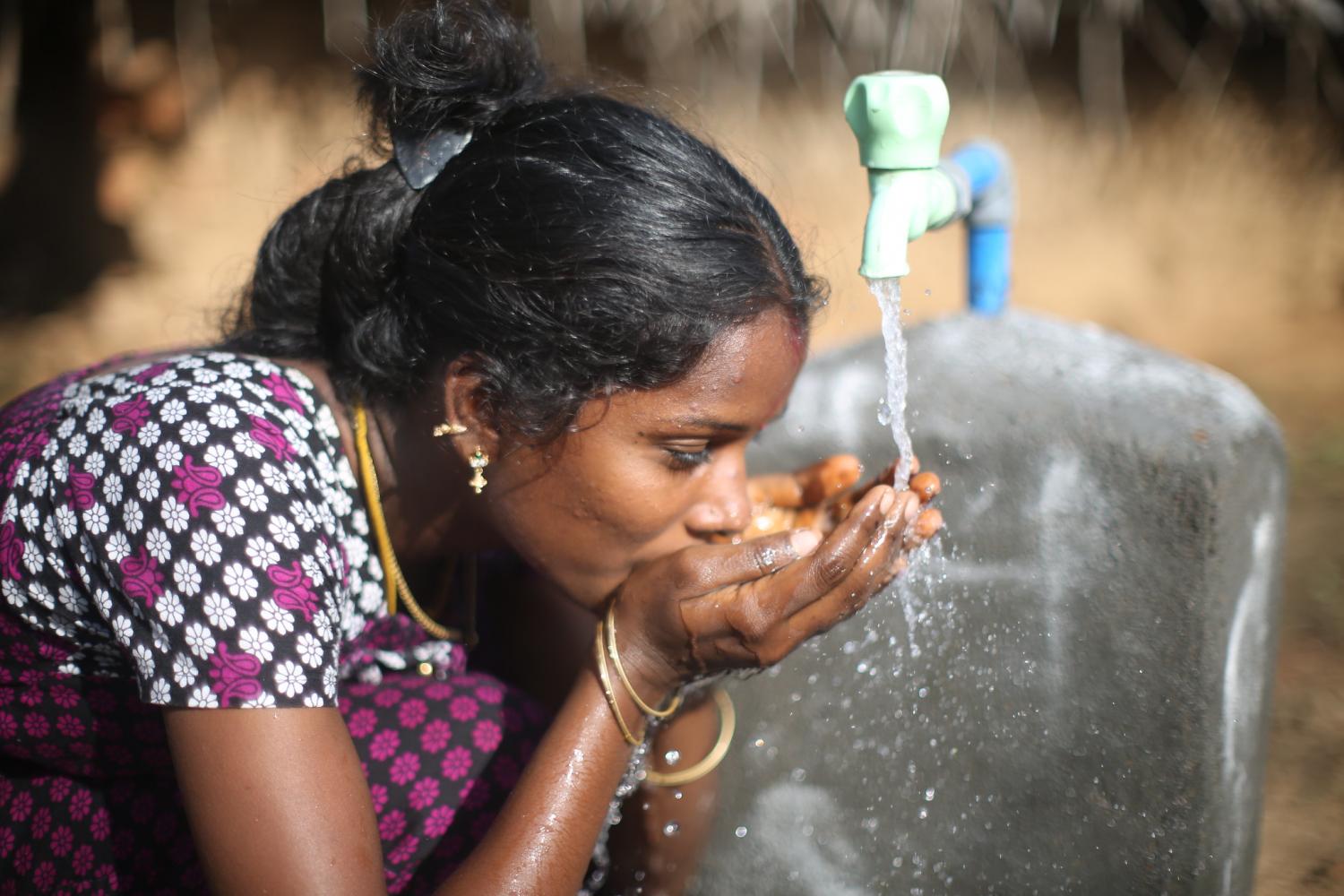
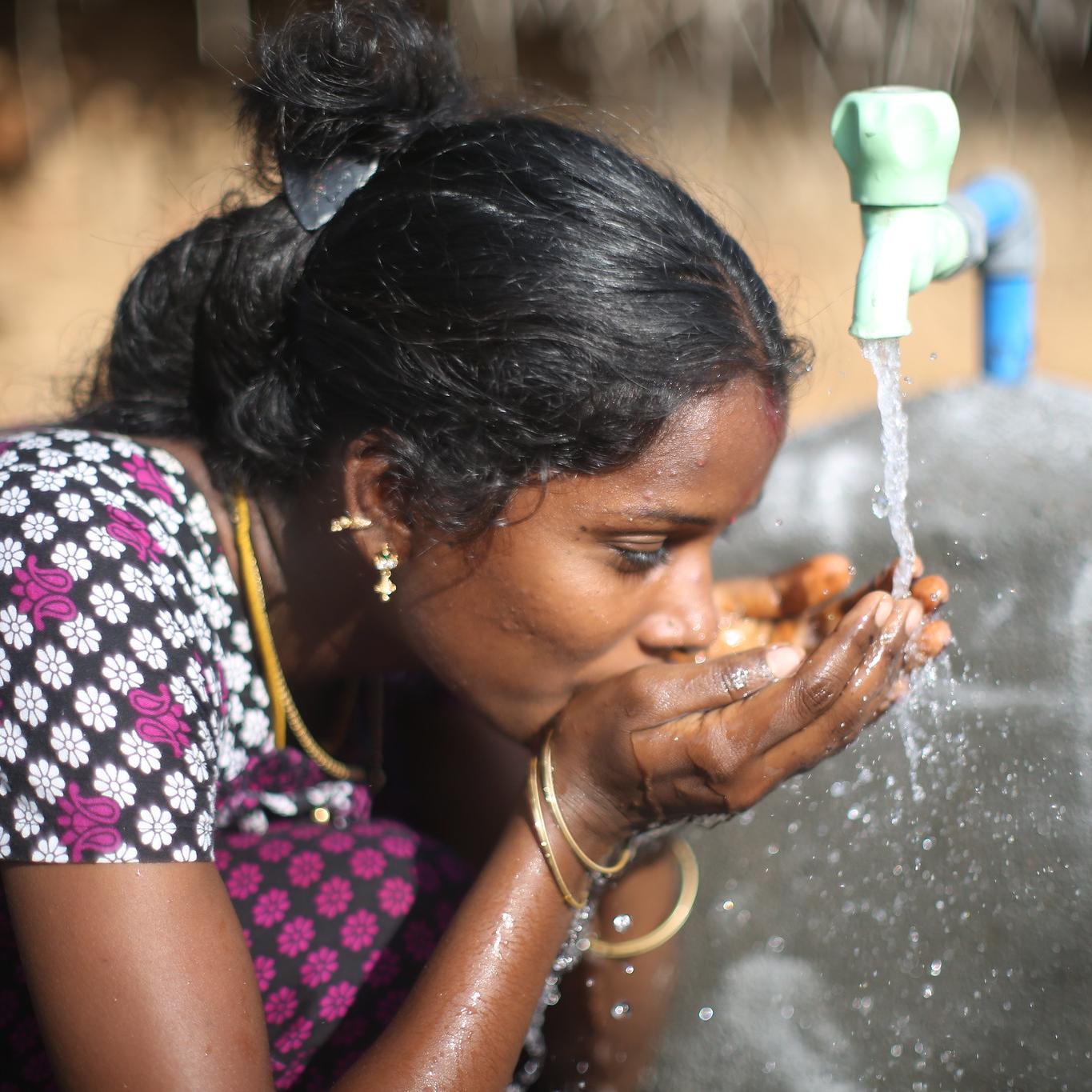
The Greenland ice sheet, which is melting at the fastest rate since the end of the last ice age, sums up what we're witnessing worldwide due to climate change. The Northern Hemisphere has just recorded its hottest summer on record, a season that saw almost nine million acres in the American West turned to ash by wildfires.
Devastating droughts and unprecedented heatwaves have kindled famines in Africa and South Asia, while record rainfall drenches Europe and Northern Asia. Climate change is here, and its devastating impacts are accelerating day by day.
The warming planet is the existential threat of our time. Not only does it inflict extreme weather events on communities of people around the world, it also magnifies existing global challenges - from inequities in health, to income inequality to resource competition and national security.
Although it’s a global issue, climate change does not affect everyone equally. Low income communities are often the hardest hit. As we work to develop climate resilience, we must lean towards the most vulnerable populations, providing them with the tools and the capital they need to combat the effects of climate change. This will require a bold rethink and reimagining of both the crisis and our response to it.
Access to safe water and sanitation is central to this. UNICEF put it plainly in 2016: “To tackle climate change we need to increase equitable access to sustainable water sources and improved sanitation.” The Intergovernmental Panel on Climate Change (IPCC) special report on global warming reinforced the point, making clear that the extent of climate-change damage will relate to the pre-existing fragility of communities. Increased access to clean water and sanitation in low-income communities allows those most at risk to cope and survive during climate change driven weather events. It also reduces water contamination and the associated disease burden that arises from open defecation during crises. And as the Rockefeller Foundation has argued within their “planetary health” framework, sanitation and waste management are becoming important resource management tools that can lower greenhouse gases, if properly implemented.
Today, worldwide, one in nine people don’t have access to safe water, and one in three don’t have access to sanitation. This is one of the most urgent issues of our time. Yet perhaps surprisingly, it is also one of the largest market opportunities of our time. There is an $18 billion market demand from low-income families in emerging markets for microcredit loans to pay for improved water and sanitation services. Providing financing to meet this opportunity would reach as many as 600 million people, and go a substantial way towards solving the water crisis globally. Moreover, water and sanitation investments are a force-multiplier for good. They reduce income inequality, improve healthcare and epidemic preparedness, mitigate gender equality, and build resilience to the effects of climate change.
At WaterEquity, we know the greatest obstacle to safe water and sanitation is access to affordable financing. We’re dedicated to forging a global capital market that closes that financial gap through smart, profitable and impactful investments. WaterEquity’s impact funds provide debt capital to high-performing financial institutions and water and sanitation enterprises in emerging markets, yielding attractive financial returns while enabling low-income families to install a piped water connection or toilet in their home.
The model is proven. WaterEquity has deployed $68 million of capital to financial institutions and enterprises in 30 debt investments across multiple regions, empowering more than 1.6 million people with access to safe water and sanitation - all while providing attractive returns to investors. We’re already hard at work on scaling our impact further, with the goal of reaching over five million people directly across East Asia and the Pacific, Latin America and the Caribbean, Africa, and South Asia, over the next seven years.
While COVID-19 occupies much of our attention at present, we cannot lose sight of the potential that climate change has to be more disruptive and more lethal than the pandemic in the long run. Fortunately, investments in safe water and sanitation alleviate both crises. Access to clean water helps people protect themselves and their communities from the virus. It also protects and gives them resilience to the challenges and disruptions we will all face as the planet warms.
Image credit: Water.org